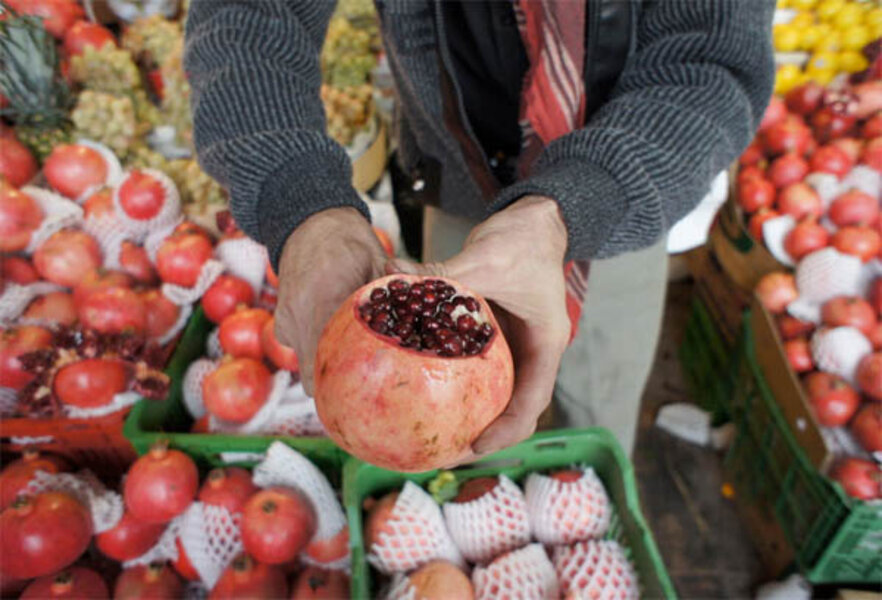Ancient and modern: Iran's lush cuisine
Loading...
Persian cuisine has survived Alexander the Great, Genghis Khan, and the conquest of Islam. So I figured I couldn't do too much damage by trying out a recipe or two myself.
Armed with Najmieh Batmanglij's newly updated cookbook, "Food of Life: Ancient Persian and Modern Iranian Cooking and Ceremonies," I marched into the supermarket to find pomegranate molasses, saffron, and barberries.
Alas, I was in Vermont. In the winter. Nary a pomegranate seed to be found. I did find saffron – in the Mexican aisle. Barberries? I didn't even know what those were. (It wasn't until later that I discovered the tiny print in an appendix: Barberries are a small, tart red fruit.)
But I was undeterred – and hungry to know something about Iran besides its controversial nuclear program, which I deal with frequently as the Monitor's Middle East editor.
With some creativity, extra hands, and the lenience of my family and our guests – "It's not like you're cooking for the shah," my husband reminded me – we pulled off respectable versions of Jeweled Rice and Pomegranate Khoresh with Chicken, a braised meat dish.
At a time when the US media seem to have forgotten that there are actual people living in Iran – people throwing snowballs, falling in love, nourishing their friends and families – it could be worthwhile for Americans to get a taste of daily life there.
That has been a key objective for Ms. Batmanglij in writing five Persian cookbooks; this latest one even includes an 18-step guide to planning an Iranian wedding, including advice (which Americans could probably heed as well) about how not to annoy your future in-laws.
From Tehran originally, Batmanglij has lived in exile since the 1979 Iranian revolution. She revealed a clear affection for her country, however, in a recent phone conversation from her kitchen in America's capital, where many elected officials and think tank analysts are pushing for increasingly harsh measures against the Iranian regime.
"Above all, I wanted Iran associated with good things – pomegranates, saffron, pistachios," says the celebrated chef, who believes Persian food reflects the same delicate touch, or letafat, that governs the Persian arts. "I wanted to show the best of Iran."
Indeed, photographs in "Food of Life" show not only beautiful meals, but everything from Persian pottery to Persian poetry, revered for centuries – not least of all as a way to express one's feelings during times of political repression.
"Traditionally people couldn't express themselves directly, so they would use poetry to speak in metaphor," says Batmanglij, adding that it is so ingrained that her mother would even scold her with poetry.
"As soon as Iranians get together they cook, tell jokes, laugh, dance, tell poetry," she says – and that is what she hopes readers of her cookbook will do.
For those new to Persian cooking, she suggests Fresh Herb Kuku, a frittata, and an adapted 16th-century reci-pe for pistachio meatballs. She takes the opportunity to exult in the size and color of green California pistachios. "I was so impressed," she says, noting that the seeds of California's "Kerman" pistachios came from Iran. When you put your masterpiece on the table, you can say, nush-e jan – which means "food of life," and is roughly equivalent to bon appétit.
After my foray into Persian cooking, I decided to check out the real thing. At the Persian restaurant Lala Rokh in Boston, the food was sumptuous, but came from the northern Azerbaijan region of Iran – and thus differed from the recipes I had tried. A delightful woman who came by the table to ask if we were enjoying our meal indulged our curiosity by explaining how diverse Iran's peoples – and thus cuisines – are. She took us on a 15-minute oral tour of her home region that began at the Caspian Sea, where fresh fish are caught daily, and moved through rice fields, luscious citrus groves, and tea plantations.
The opportunities for Americans to enjoy such Persian restaurants – and interactions – are slim, however. Why? Who could resist saffron rice be-jeweled with thinly sliced pistachios and slivers of carrot and orange rind?
A key reason is that Iran doesn't share the same restaurant tradition as the United States, Batmanglij told me. Persian food is eaten at home, while restaurants carry foreign foods like pizza and hamburgers.
But it's also political. After the revolution in 1979, during which Iran kept 52 Americans hostage for 444 days, it was "politically incorrect" to open an Iranian restaurant in the US, says Batmanglij, which is why some brand themselves simply as "Middle Eastern" even if their cuisine is purely Iranian.
"Hopefully things will change little by little," she says.
Yes, barberry by barberry.







